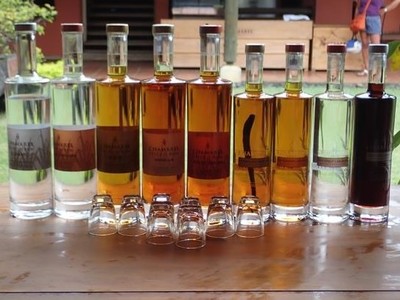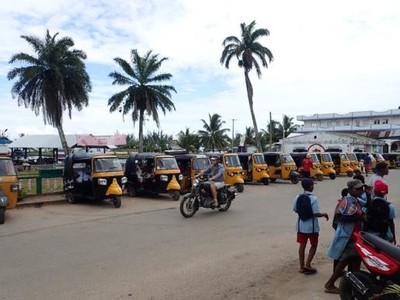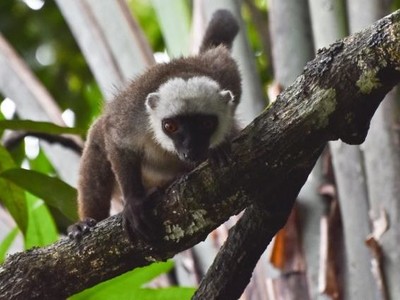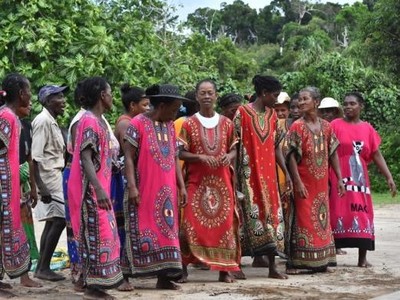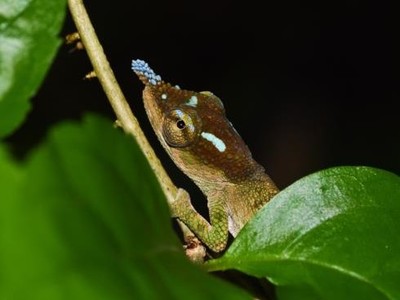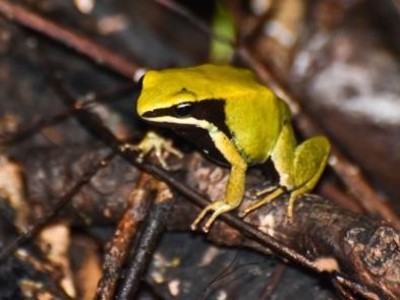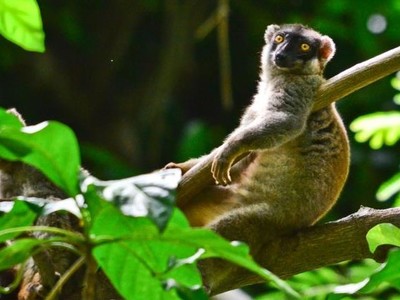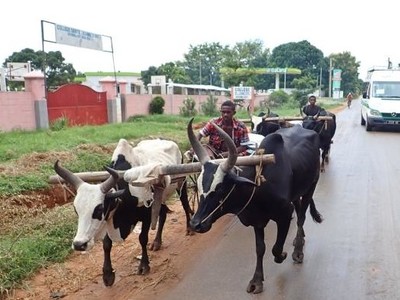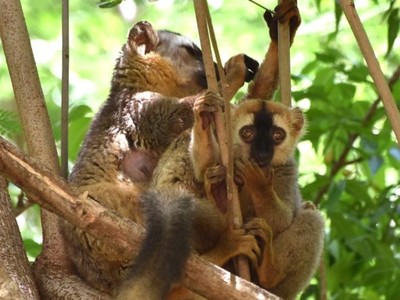Wonders of Madagascar
4th to 17th January 2020
Mauritius to Tulear, Madagascar aboard the MS Serenissima
Saturday, 4th January 2020 - Port Louis, Mauritius
Mauritius was grey and rainy as we started our Indian Ocean adventure. Most of us had enjoyed a tour of the island, seeing the natural wonders, the sacred lake, waterfalls and coloured sands. We had lunch in a restaurant overlooking forest clad hills, a lunch that included sago that was nothing like the stodge fed to many of us at school. The drive to the port introduced us to Mauritius traffic, a result of too many cars and too few roads. Not to mention the kamikaze motorcyclist who decided to take a short cut around the wrong side of the traffic circle and nearly got flattened by our bus. A visit to a rum distillery, and the chance to sample the local product was just the right thing to get us into the mood for a tropical cruise. We did reach the ship in time, and once aboard were given the usual welcome with bubbly and eats before knuckling down to the mandatory safety and abandon ship briefing, including the issuing of our Zodiac lifejackets, the ship familiarisation briefing and the introduction of the expedition team, all this followed by the first of many good dinners. The mountains of Mauritius, shedding their cloudy cloak, faded into the dusk as we set sail across a calm sea toward the neighbouring island of Reunion.
Sunday, 5th January 2020 - La Reunion, France
Dawn revealed the cloud wreathed mountains of…France! Reunion is indeed a Department of France, so we had beautiful smooth roads, gendarmes, French cafés, all in a tropical climate. The ship was cleared efficiently by the French authorities and there was the first experience of swapping room keys for ship’s ID cards and being allocated to coaches for the day’s tours. The half day tour to Salazie took us into the steep canyons carved by water over the ages. The weather was distinctly damp, but the rain served to make the many waterfalls, including the spectacular Le Voile de la Mariée even more impressive. The vanilla farm at St Andre was a learning experience, where the techniques of pollinating these orchids and the processing of the pods were explained to us. Of course, there was a welcome tasting of vanilla flavoured products, and the chance to buy top quality vanilla at source. The full day tour to the Piton de la Fournaise took us around the coastline of the island, past beautiful beaches which are unfortunately closed to swimmers because of sharks, little towns named after saints, and many beautiful views. Finally, we turned inland and started the long, winding climb up to the volcano. More little villages, the guides keeping us amused and educated with stories of the origin of the villages and life in days gone by. As the coach navigated the twisting roads, skilfully driven, the temperature dropped, and the clouds and rain visited us briefly. The temperature dropped as we climbed, and the vegetation changes from tropical lush to sparser montaigne growth. The great fear was that the clouds would stay down and that all we would see would be swirling grey mists, without a crater in sight. Fortunately the clouds broke to give us atmospheric views into the crater, for many of us the first time we had looked into the maw of a still active volcano. Down the twisting roads to Plaine des Caffres for lunch, a chance to sample genuine Creole cooking, and then a visit to the excellent volcano museum Cité de Vulcan with its 4-D volcano experience before returning to the ship. Bucketing rain was not the best encouragement for a beach afternoon at St Gilles, but a few hardy souls ventured out to explore this quaint seaside town. A rainbow heralded better weather as we sailed from the European ambiance of Reunion to the African experience of Madagascar.
Monday, 6th January 2020 - At Sea
The sea was blue and calm as we sailed across the Indian Ocean to Madagascar. There was plenty of time to relax and watch the passing sea, or hope to catch a glimpse, or even better a picture, of a flying fish as it fled from the threat of the ship. There were many other activities to keep us occupied. There were the mandatory briefings, designed to ensure our safety while swimming, snorkelling or riding in the Zodiacs. These were followed by the issue of snorkel gear, with much trying on of masks and flippers, and serious discussions on how to keep the water out of bearded faces. We were fed, of course, and entertained by the first of our talks. Damon Ramsey gave us an Introduction to Madagascar and Lea McQuillan taught us how to identify the fish we hoped to see with her talk What Fish is That? Finally Pierre Malan told us a bit about The Sea Beneath Us in his talk on oceanography. Then it was time to get spruced up for the Captain’s welcome cocktails and dinner.
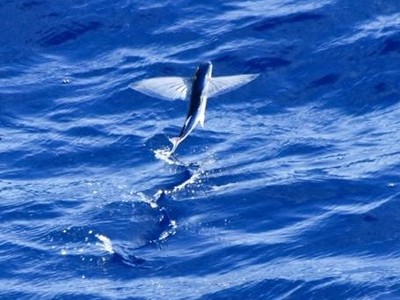
Tuesday, 7th January 2020 - Ile ste Marie, Madagascar
Madagascar!
The officials trooped aboard to clear us into the country. We were at Ile ste Marie, our first stop on this magical island nation. It was also our first Zodiac ride into the little harbour. This was Africa! No more shopping malls, no more smooth roads, just the humming vibrance of an African town. After emptying out the only ATM in town and becoming Ariari millionaires, we were taken on walks through the market, up to the church and cemetery and then had a chance to relax, order a drink, and enjoy the buzz of the town. And what a buzz! Tuk-tuks, scooters, bicycles and rickshaws, people walking everywhere, going about their daily business. Road Rules? Apparently not. Great chunks of meat, chickens and ducks in wicker cages, strange fruits and vegetables. An incredible assortment of ingenious home-made appliances. A man repairing umbrellas. Fresh, and not so fresh fish. The school and its children, all dressed in their blue smocks, charmed most of us, despite the actual buildings being a stark contrast to what we were accustomed to at home. We explored, looked, wondered, and wandered and then it was time to return to the ship for lunch and a cooling off spell in the air-conditioning. We repositioned a few miles and in the afternoon we hit the beach! Snorkel lessons, swimming and our first walks into the bush. For some of us our first sight of a lemur, having a snooze in a tree. The beach was classic tropics. Calm, clear water, white sand, palm trees. It was perfect for trying out our snorkel gear. For some it was a case of rediscovering an old skill, for others it was a whole new experience! There was plenty of sandy bottom for learners, and some good patches of coral for the more adventurous. And there was Nemo City! An outcrop of coral just teeming with the delightful little anemone fish. Most people opted to walk and explore, although there was one couple who stayed put, and ended up having a tropical beach all to themselves. Time waits for no man, and with the sun dipping towards the horizon it was time to leave the beach and return to the ship after a very good day.
Wednesday, 8th January 2020 - Nosy Mangabe and Ambodiforaha, Madagascar
A short overnight passage to the mainland of Madagascar took us to Nosy Mangabe, a tiny island reserve in the bay of Masoala. This was to be our first real experience of rainforest, and imposed on us the need to make decisions regarding which walks to do. Long walk, medium walk or short walk, that is the question? “On which walk will we see more wildlife?” That was the question on everyone’s lips. “It all depends on the wildlife” was the unhelpful answer. The lemurs know all the tricks, so they were there on the beach, okay, the trees above the beach, to welcome us. These were white-fronted brown lemurs, regular visitors to the landing site. Off we went on our walks, amazed by the camouflage of the leaf-tailed geckos, the brightly coloured mantella frogs, intrigued by the brief glimpses of kingfishers and flycatchers. Not to mention a female panther chameleon busily covering up the hole she had just dug to bury her eggs and all sorts of other wonders of the forest. The lemurs continued to make cameo appearances, keeping us on our toes. Huge blue butterflies teased the photographers, landing for just long enough so that we thought we could get a pic, then taking off to land elsewhere. We walked, and we watched, we were amazed, we sweated! Oh! How we sweated! The sea was warm and welcoming off the sandy beach, so many enjoyed a cool plunge after the hot walks. Others kept on finding new wonders! A tiny panther chameleon, a Platypelis frog, plated lizards, tree climbing crabs. A world of natural wonders!
Back into our Zodiacs and off to the ship, aircon and lunch as we sailed a few miles to the village of Ambodiforaha, the next stop in the day’s adventures. There were several options for the afternoon’s activities. A medium walk, a short walk, a birding walk and a visit to the village. The various walks all delivered wildlife, from chameleons to lemurs, and many birds. Some walks were easier than others, but all were rewarding. At the village we had an opportunity to see how people live their everyday lives. We were received with great openness and friendliness. On the football field, which was not quite up to FIFA standards, the village women entertained us with local dancing. Some of us even joined in! The villagers enjoyed the entertainment as much as we did, perhaps more, because at times the roared with laughter at jokes we could not understand. The Zodiacs headed back to the Serenissima after a full and satisfying day.
Thursday, 9th January 2020 - Ambodiforaha, Madagascar
We spent the night at anchor off Ambodiforaha and the next morning was spent doing more walks, mainly looking for birds, or just enjoying the beach. Once again the wildlife was cooperative. The birders found a particularly cooperative Madagascar kestrel that seemed determined to let us take good pictures. It posed attractively on several perches around the football field, making sure it was seen and photographed. Of course, no day in Masoala is complete without a downpour! For a quarter of an hour or so the rain came down in torrents! The birders managed to find shelter under a shed, while some of the others were welcomed into the local shop/pub. The rain soon marched off into the distance, trailing grumbles of thunder. We returned to the Zodiacs in steamy sunshine as the ship prepared to sail for Diego Suarez, our next port of call. The afternoon at sea was a welcome chance to relax after a few days of sometimes strenuous walks in unaccustomed heat and humidity. During the afternoon Conrad and Frankie prepared us for the next few days, telling us about the plants and birds we were likely to see in the days ahead.
Friday, 10th January 2020 - Diego Suarez, Madagascar
We had a morning at sea as we approached the huge bay of Diego Suarez. Chef Michael gave us a demonstration of the techniques he uses to create the wonderful fruit carvings that decorate the buffet table every lunchtime. This was followed by Damon’s talk “Charismatic Chameleons and Goofy Geckos", a look at the unique reptiles to be found in Madagascar. We had the luxury of docking in Diego Suarez, allowing some of us to take the opportunity of a pre-lunch walk into town. This was a great opportunity to just stroll around and absorb the atmosphere without the constraints of being part of a group of people. After lunch we embarked on the first of our overland adventures in Madagascar. Once again, we were required to make decisions! Amber Mountain? Domaine de Fonteney? Or the City Tour. For all of us this was a first experience of Malagasy roads and Malagasy traffic. Most of us opted for the Amber Mountain National Park. We were loaded into a fleet of four-wheel drive vehicles for the journey into the rain forest. The roads were bumpy and potholed and the traffic seemed chaotic as we drove through the town and then into the countryside. They journey allowed us some insight into the lives of the people, their agriculture and the countryside. There were sudden stops as sharp-eyed guides spotted chameleons in the shrubbery beside the roads. Clearly their excellent camouflage was not against the eyes of the guides. Passing through the town on Joffreville, where those going to the Domaine branched off, we left the motorway and discovered why we needed the 4x4s! Slip! Slide! Bounce! Weave around the potholes and puddles! Up we went into the forest, the air markedly cooler as we climbed. It was wilder now, with less sign of agriculture although still plenty of people walking along the roadside, many chewing the leaves of Kat, a mild narcotic that grows well in the area.
The walks through the forest were interesting, with plenty of wildlife, although it was not always easily visible. The lemurs were there, up in the trees and not easy to see, but there was so much else! Frogs, different chameleons from those we had seen before, lizards, spiders, some beautiful butterflies and birds, including the very rare crested ibis. The crowned lemurs played hide and seek in the trees, allowing most of us at least a tantalising glimpse of these animals, unique to Madagascar. There were a number of new, to us, chameleon species. Along the road we had seen Oustelet’s chameleon, the largest of them all, and the ubiquitous panther chameleon. In the park we could add the bluenosed chameleon, the elephant ear chameleon, as well as the tiny Brookesia, among the smallest in the world.
The mandatory downpour soaked and refreshed us. Leaving the park we made our way back to Joffreville for a refreshment stop and the chance to buy t-shirts and spices before returning to the ship.
Saturday, 11th January 2020 - Nosy Hara, Madagascar
Time and tide wait for no man, and at Nosy Hara this was to dictate our day for us. The only time we could get over the reef and onto the beach was in the early morning. Thus, it was a 0700 departure for those of us going ashore to do the morning walk. Nosy Hara is known as the place where you find the tiniest chameleon on the world, Brookesia micra. This tiny chameleon lives in the leaf litter, yet our guides were keen eyed enough to spot them and show them to us. Being able to see such an incredible animal in the flesh is a real privilege! The Brookesia were not the only treats awaiting the keen eyed along the steps leading up the hill. There was a python, going about its business of hunting small animals. It lay there, motionless, until a Mantella frog came hopping past. Quick as a flash the snake struck, and the frog had vanished in mid jump. The insects were interesting. A nest of wasps was fascinating to watch, although one had to be careful not to disturb them, the consequences of the rash move would have been painful! With the tide ebbing fast, it was time to return to the beach and catch a Zodiac before the bay became too shallow for the boats to operate. That was not the end of the morning’s entertainment. The falling tide made the reef easily accessible to snorkellers, and there was a treat in store for us under the water. There was a landscape of beautifully healthy coral, unusual in an area where intensive fishing often destroys coral due to careless fishing practices. There were not many large fish, but the coral and the small fish made up for this. The sea was warm and calm, and one could drift quietly enjoying the beauty of nature at its best. There was action and beauty above the water as well. In the afternoon we went Zodiac cruising along the coast, giving us a different perspective of the rugged terrain. Birdlife was sparse, and rain threatened but failed to deliver yet another downpour. The white-tailed tropicbirds put on a spectacular flying display for us, sometimes individual birds, and more rarely a pair of birds flying in formation. There were other birds, dimorphic egrets, lesser-crested terns, and a few fortunate people saw the Madagascar fish eagle. A few people opted to make a beach afternoon of it. After all, we are on holiday!
Sunday, 12th January 2020 - Nosy Tanikely, Madagascar
Another day, another beautiful destination.We sailed into the very commercial area of Nosy Be for clearance before relocating to the little island gem of Nosy Tanikely. Tanikely means small, and this island really is small. We Zodiaced ashore to be greeted by our guides. There was a walk up the hill to the lighthouse, a trail with many steps, but well worth the effort because the Black Lemurs, introduced to the island, were in an entertaining mood. The sweaty walk was well worth the effort, with wonderful views from the top and the lemurs to entertain us. We watched the lemurs, and the lemurs, it seemed watched us. One wonders what goes through a lemur’s head as he watches yet another bunch of curious humans, pant up the hill to gawp and point at them. Perhaps? “Strange creatures. I wonder how they evolved into those odd shapes and colours? And what are those things they keep on pointing at us?” The beach and the sea were a great attraction. It was a beach snorkel, and it was also the last opportunity to enjoy the wonderful sea life. The coral here was not as good as at Nosy Hara, but the fish made up for the coral! There were dozens of species we had not seen before, from brightly coloured wrasses to a little flounder who was so well camouflaged that one could only see him when he moved. It seemed that the fish and the lemurs shared the curiousity about humans. Many fish approached us, some swimming right up to our masks if we lay still enough. Were they curious? Or were they defending their territory in a real David and Goliath confrontation? Alas, all good things must come to an end and all too soon it was time to leave. The afternoon was spent at sea on our way to Mahajanga. Scotty, our smiling security team leader, told us all about the piracy threat in the Indian Ocean, after which Conrad told us more about the mammals of Madagascar.
Monday, 14th January 2020 - Mahajanga and Ankarafantsika National Park
We anchored in the bay at Mahajanga in the early light. The fishing fleet was on its way out, dozens of outrigger canoes driven by lateen sails. Interspersed with these were trading ketches, looking as if they came from a 19th century watercolour, their sails often a patchwork of fabric, but still providing motive power. At the landing site we were greeted by…chaos. There were welcoming dancers supplied by the tourism department, as well as a pop-up tourist office. Local boats were being loaded around us, while a flock of Helpful Harrys insisted on assisting us. Gendarmes wielding AK-47s wandered around idly. Amid all this we managed, most of us, to get ashore dry-shod. We were loaded into an assortment of mini-buses and set off for the Ankarafantsika National Park. It was Monday morning rush hour! Rickshaws, bicycles, ox-carts, overloaded taxis and pickup trucks, not to mention hundreds of pedestrians thronged the narrow streets, streets bordered by stalls selling just about anything imaginable. For those who thought the roads in Diego Suarez were bad, Mahajanga was an eye-opener! We bumped and weaved and hooted our way through the throng until we reached the countryside. The vegetation was very different from what we had seen in the north, and there were many more rice paddies. The average Malagasy eats 120 kilograms of rice a year! It was a long drive, made longer by the damage to the roads wrought by the cyclone that passed through the are in December 2019. For some of us the ride was made a bit more exciting by mechanical breakdowns, or an explosive tyre blowout. Rescued by the spare vehicle, we all made it to the park.
Here, things improved. We had taken longer than expected to get there, so walks were curtailed somewhat. On the other hand, coquerel’s sifaka had come to the campsite to welcome us! They lolled in the trees, giving all of us a good view. The walks, while shorter were productive. We saw snakes, and spiny-tailed lizards. There were insects aplenty, and a few chameleons. The birds were shy in the middle of the day, but the sightings we did have were good. One prize was a male, white morph Madagascar paradise flycatcher sitting on his tiny, cup-shaped nest, totally ignoring us as we peered through the leaves to see him. There were Madagascar coucals and pond herons and many others. Lunch gave us an introduction into local cuisine. Zebu stew, among others. The alternative town tour gave us an insight into how people live in this ancient trading town. Reba undertook a solo mission to present our donations to a local school. This was very well received by the children and the staff. Once we all returned to the port we made our way through the hangers-on and found our Zodiacs, ready to take us back to the ship. Showers, dinner and aircon were very welcome!
Tuesday, 15th January 2020 - At sea to Morondava
After the preceding busy days, a day at sea was a welcome holiday. The sea was calm and we could relax and watch the sea go by. Pierre entertained us with his Afrocentric view of the exploration of the Indian Ocean under sail and the trade patterns governed by the trade winds in his talk, “The Wind is Free”. In the afternoon Frankie told us more about camouflage in nature in his talk “The deception of Perception – Camouflage in Nature.”
Wednesday, 16th January 2020 - Morondava and Kirindy National Park, Madagascar
It was a wet landing! There was a dumping little wave that ensured that most of us were at least a bit damp as we boarded the fleet of 39 vehicles for the drive out to Kirindy Forest. At first the road was good, but then we turned off the tar road and began a four-wheel drive adventure. The road was full of puddles. Puddles? Perhaps ponds or small lakes would be a better description. We saw baobabs. Just one, then another, then more, then lots. Tall, stately trees! The stop at the Avenue of the Baobabs was a highlight, walking down the majestic avenue between the trees. There were other treats, birds and chameleons along the way. Snakes and lizards, and butterflies! Thousands of butterflies! Finally, somewhat delayed by the state of the roads. We arrived at the Park. The welcoming committee was waiting for us. A team of guides, and a troop of white-fronted brown lemurs that cavorted in the trees and sometimes walked between us. As the stream of vehicles arrived, we were quickly divided into walking groups and sent off to see what we could find. There was lots to find! Sifakas! Hognosed snakes. Birds of many varieties. There were many spine-tailed lizards, and some of us were fortunate enough to see female lizards digging their nest holes. The length of the walk mattered little, it was the quality of the sightings that counted. Lunch was served in the park restaurant, and very good it was too. Of course, there had to be the inevitable torrential downpour, just as the last walkers came in. Then it was back into the vehicles for the long but interesting drive back to the ship. A quick shower and spruce up, a dusting off of diamond tiaras, and we were ready for the captain’s farewell dinner.
Thursday, 16th January 2020 – Tulear, Madagascar
All good things must come to an end, and this was the last full day of our cruise. We docked at Tulear in mid-morning, after Conrad's final talk about Kew Gardens. The ship was soon surrounded by local canoes selling souvenirs, including items like turtle shells. For boat lovers the beautifully decorated canoes, all working boats, were a treat for the eye. After lunch we headed off for our last tours, with a choice between the Reniala Private reserve and a tour of the Arboretum. It was hot, but the tours gave us a very good opportunity to learn more about the plant life in the area and in particular about the baobabs. One tree was reputedly 1600 years old! The trees and other vegetation was home to many species of reptile, including Standing’s Day Gecko and the curious Three Eyed Lizard. The birds were plentiful, although most were small and quite secretive. Even so, the keen birders had a good afternoon. The Reserve includes a lemur rehabilitation centre, where captive lemurs are prepared for a return to the wild. This was our chance to see the legendary ring-tailed Lemur, albeit in large cages. Hot, sweaty, and with our water bottles empty, our visit to the Dunes Hotel was very welcome, as were the cold drinks on offer. The drive to the ship gave us a last look at the Malagasy countryside. As we had our pre-dinner drinks we could watch our last golden Madagascar sunset. It has been a wonderful cruise, with great adventures and many new wonders.
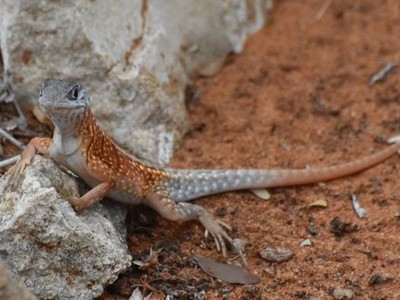
End of Voyage
For further inspiration, view slideshow of images taken during the voyage






